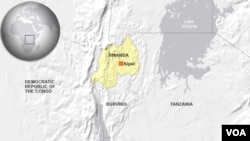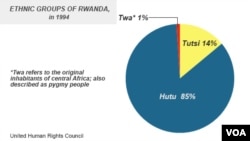KIGALI —
As Rwanda marks 20 years since the genocide, a group of visitors from a U.S. Holocaust memorial are touring sites around the country, drawing connections between two of the worst atrocities in the 20th century.
A wooden shelf stacked floor-to-ceiling with skulls and bones fills the back wall of the Ntarama Church Memorial outside Kigali. It was here, a tour guide explains, that some 5,000 people were killed during the genocide of 1994.
Coffins of some of the dead lie on the pews. The victims' ragged clothing hangs from strings tied to the ceiling.
Angelique Mukabukizi was among the few survivors of the attack here. A young mother at the time, only survived because the killers who thought they were executing her did not realize after they finished hacking at her body that she was still breathing.
Now, bearing scars on her neck and arms, she tells her harrowing story to a group of visitors from the United States.
As difficult as her experience has been, Angelique feels it is crucial to tell the world what happened in this place.
“If someone comes to visit the memorial and asks me for the testimony, I do it confidently," she explainied. "It is like showing him the history of Rwanda. We cannot hide it and if he understands it can be a good lesson for him and the rest of the world.”
The group visiting this day knows full well the importance of learning lessons from the past. It is part of a delegation from the U.S. Holocaust Memorial Museum in Washington.
Michael Abramovitz, the director of the museum's Center for the Prevention of Genocide, says one of the main functions of memorial sites is to ensure that history is not forgotten.
“We really want to focus part of our efforts at the museum on raising awareness, raising consciousness that genocide did not end after the Holocaust, sadly, and that we have a long way to go to realize our collective vision of 'never again," Abramowitz said.
Touring these memorial sites in Rwanda, is a different experience from visiting a museum, he noted.
“We are only 20 years after the genocide in Rwanda and about 75 years after the Holocaust," Abramowitz said. "What happened here is rawer and there's no substitute for actually being at the place where these crimes happened. And that's a very powerful thing.”
There are numerous sites across Rwanda like the Ntarama church, where the real bodies of victims are left on display and the walls still bear bullet holes describing unspeakable violence -- powerful reminders to the living of the not-so-distant past.
Ildephonse Karengera, director of memory and prevention of genocide at Rwanda's anti-genocide commission, says these emotional memorial sites give victims a space to confront the past, and to find some comfort.
“It takes them back to the period in which they were living during the genocide. But also it is a relief for them because they can cry, they can express themselves, they can give testimonies of what happened,” Karengera said.
Some critics have taken issue with Rwanda's memorials, which strongly emphasize that ethnic Tutsis - the vast majority of the 800,000 people killed - were the ones targeted by extremist Hutus, while paying less attention to moderate Hutus who also died.
Kerengera argues that during the genocide, Hutus were only killed because they refused to kill, were married to a Tutsi, or they physically resembled Tutsis.
“So those Hutus are among those we call victims of genocide against the Tutsi, but we call it 'genocide against the Tutsi' simply because it was the Tutsi who were targeted for extermination, it is not the Hutu,” Karengera said.
Rwanda officially begins commemoration of the genocide on April 7, in Kigali, when President Paul Kagame lights a national flame of mourning with a torch that has been touring across the country since the beginning of the year.
A wooden shelf stacked floor-to-ceiling with skulls and bones fills the back wall of the Ntarama Church Memorial outside Kigali. It was here, a tour guide explains, that some 5,000 people were killed during the genocide of 1994.
Coffins of some of the dead lie on the pews. The victims' ragged clothing hangs from strings tied to the ceiling.
Angelique Mukabukizi was among the few survivors of the attack here. A young mother at the time, only survived because the killers who thought they were executing her did not realize after they finished hacking at her body that she was still breathing.
Now, bearing scars on her neck and arms, she tells her harrowing story to a group of visitors from the United States.
As difficult as her experience has been, Angelique feels it is crucial to tell the world what happened in this place.
“If someone comes to visit the memorial and asks me for the testimony, I do it confidently," she explainied. "It is like showing him the history of Rwanda. We cannot hide it and if he understands it can be a good lesson for him and the rest of the world.”
The group visiting this day knows full well the importance of learning lessons from the past. It is part of a delegation from the U.S. Holocaust Memorial Museum in Washington.
Michael Abramovitz, the director of the museum's Center for the Prevention of Genocide, says one of the main functions of memorial sites is to ensure that history is not forgotten.
“We really want to focus part of our efforts at the museum on raising awareness, raising consciousness that genocide did not end after the Holocaust, sadly, and that we have a long way to go to realize our collective vision of 'never again," Abramowitz said.
Touring these memorial sites in Rwanda, is a different experience from visiting a museum, he noted.
“We are only 20 years after the genocide in Rwanda and about 75 years after the Holocaust," Abramowitz said. "What happened here is rawer and there's no substitute for actually being at the place where these crimes happened. And that's a very powerful thing.”
There are numerous sites across Rwanda like the Ntarama church, where the real bodies of victims are left on display and the walls still bear bullet holes describing unspeakable violence -- powerful reminders to the living of the not-so-distant past.
Ildephonse Karengera, director of memory and prevention of genocide at Rwanda's anti-genocide commission, says these emotional memorial sites give victims a space to confront the past, and to find some comfort.
“It takes them back to the period in which they were living during the genocide. But also it is a relief for them because they can cry, they can express themselves, they can give testimonies of what happened,” Karengera said.
Some critics have taken issue with Rwanda's memorials, which strongly emphasize that ethnic Tutsis - the vast majority of the 800,000 people killed - were the ones targeted by extremist Hutus, while paying less attention to moderate Hutus who also died.
Kerengera argues that during the genocide, Hutus were only killed because they refused to kill, were married to a Tutsi, or they physically resembled Tutsis.
“So those Hutus are among those we call victims of genocide against the Tutsi, but we call it 'genocide against the Tutsi' simply because it was the Tutsi who were targeted for extermination, it is not the Hutu,” Karengera said.
Rwanda officially begins commemoration of the genocide on April 7, in Kigali, when President Paul Kagame lights a national flame of mourning with a torch that has been touring across the country since the beginning of the year.










